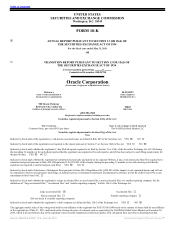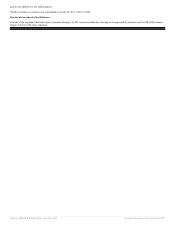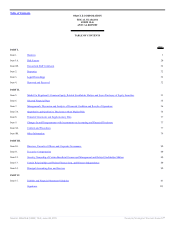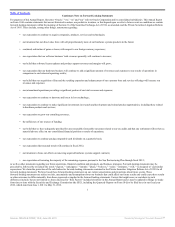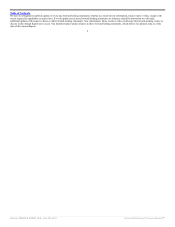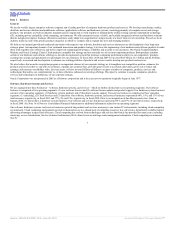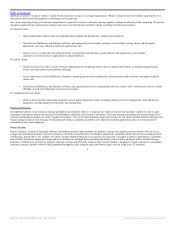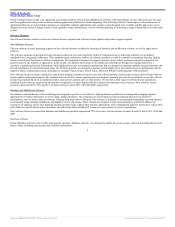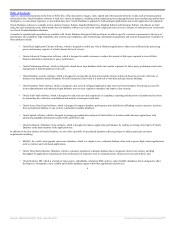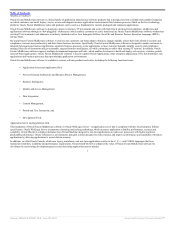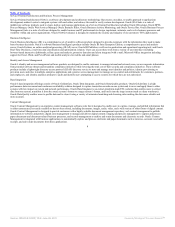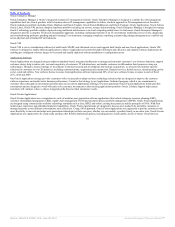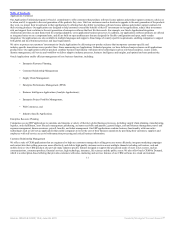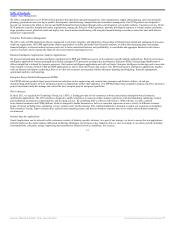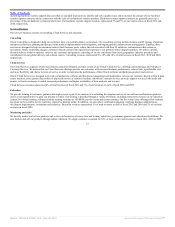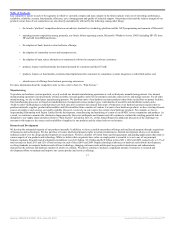Oracle 2010 Annual Report Download - page 12
Download and view the complete annual report
Please find page 12 of the 2010 Oracle annual report below. You can navigate through the pages in the report by either clicking on the pages listed below, or by using the keyword search tool below to find specific information within the annual report.
Table of Contents
Service-Oriented Architecture and Business Process Management
Service-Oriented Architecture (SOA) is a software development and architecture methodology that creates a modular, re-usable approach to applications
development; makes it easier to integrate systems with each other; and reduces the need for costly custom development. Oracle SOA Suite is a suite of
middleware software products used to create, deploy, and manage applications on a Service-Oriented Architecture including Oracle JDeveloper, Oracle BPEL
Process Manager, Oracle Web Services Manager, Oracle Business Rules, Oracle Business Activity Monitoring, and Oracle Service Bus. Oracle Business Process
Management Suite is a suite of software designed to enable business and IT professionals to design, implement, automate, and evolve business processes and
workflow within and across organizations. Oracle SOA Governance is designed to maintain the security and integrity of our customers’ SOA deployments.
Business Intelligence
Oracle Business Intelligence (BI) is a comprehensive set of analytic software products designed to provide customers with the information they need to make
better business decisions. Oracle’s software Business Intelligence products include Oracle BI Suite Enterprise Edition, a comprehensive query and analysis
server; Oracle Essbase, an online analytical processing (OLAP) server; Oracle BI Publisher, a self-service production and operational reporting tool; and Oracle
Real-Time Decisions, a real-time data classification and optimization solution. Users can access these tools from a variety of user interfaces including
browser-based interactive dashboards; ad hoc query and analysis; proactive detection and alerts integrated with e-mail; Microsoft Office integration including
support for Excel, Word, and PowerPoint; and mobile analytics for mobile and smart phones.
Identity and Access Management
Oracle’s identity and access management software products are designed to enable customers to manage internal and external users, secure corporate information
from potential software threats and streamline compliance initiatives while lowering the total cost of their security and compliance initiatives. These software
products include a lightweight directory access protocol (LDAP) directory service to store and manage user identities and policies; identity provisioning to
provision users and roles in multiple enterprise applications and systems; access management to manage access control and entitlements for customers, partners,
and employees; and identity analytics products to audit and identify users attempting to access systems for which they are not authorized.
Data Integration
Oracle’s data integration offerings consist of Oracle GoldenGate, Oracle Data Integrator, and Oracle Data Quality products. Oracle GoldenGate is a high
performance data movement and continuous availability solution designed to capture transaction records on one system and to move and apply them to other
systems with low impact on system and network performance. Oracle Data Integrator is an extract-transform-load (ETL) solution that enables users to extract
data from one system, transform it from the source system’s format to a target system’s format, and load it into the target system (such as a data warehouse).
Oracle Data Quality enables users to profile data and to clean it using a variety of automated matching and cleansing rules making the data more reliable and
more accurate.
Content Management
Oracle Content Management is an enterprise content management software suite that is designed to enable users to capture, manage, and publish information that
is either unstructured, not easily readable or has not been stored, including documents, images, audio, video, and a wide variety of other forms of digital content.
Oracle Content Management is designed to provide customers with a highly scalable document management repository; web content management to publish
information to websites and portals; digital asset management to manage and deliver digital content; imaging and process management to capture and process
paper documents and document related business processes; and records management to archive and retain documents and electronic records. Oracle Content
Management is integrated with business applications to automatically capture and process electronic and paper documents such as invoices, accounts receivable
receipts, and sales order documents from these applications.
8
Source: ORACLE CORP, 10-K, June 28, 2011 Powered by Morningstar® Document Research℠


